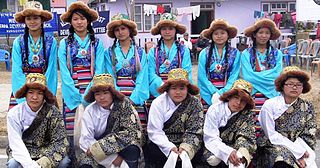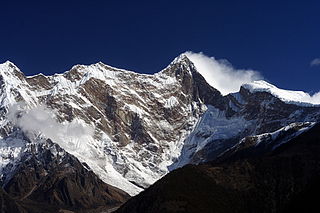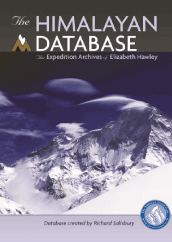
Kangchenjunga, also spelled Kanchenjunga, Kanchanjanghā and Khangchendzonga, is the third-highest mountain in the world. Its summit lies at 8,586 m (28,169 ft) in a section of the Himalayas, the Kangchenjunga Himal, which is bounded in the west by the Tamur River, in the north by the Lhonak River and Jongsang La, and in the east by the Teesta River. It lies in the border region between Nepal and Mangan district, Sikkim state of India, with three of the five peaks, namely Main, Central and South, directly on the border, and the peaks West and Kangbachen in Nepal's Taplejung District.

Mountaineering, mountain climbing, or alpinism is a set of outdoor activities that involves ascending mountains. Mountaineering-related activities include traditional outdoor climbing, skiing, and traversing via ferratas that have become sports in their own right. Indoor climbing, sport climbing, and bouldering are also considered variants of mountaineering by some, but are part of a wide group of mountain sports.

The Sherpa are one of the Tibetan ethnic groups native to the most mountainous regions of Nepal, Tingri County in the Tibet Autonomous Region and the Himalayas. The term sherpa or sherwa derives from the Sherpa-language words ཤར shar ("east") and པ pa ("people"), which refer to their geographical origin in eastern Tibet.

Tenzing Norgay, born Namgyal Wangdi, and also referred to as Sherpa Tenzing, was a Nepali-Indian Sherpa mountaineer. He was one of the first two people known to certainly reach the summit of Mount Everest, which he accomplished with Edmund Hillary on 29 May 1953. Time named Norgay one of the 100 most influential people of the 20th century.

Cho Oyu is the sixth-highest mountain in the world at 8,188 metres (26,864 ft) above sea level. Cho Oyu means "Turquoise Goddess" in Tibetan. The mountain is the westernmost major peak of the Khumbu sub-section of the Mahalangur Himalaya 20 km west of Mount Everest. The mountain stands on the China Tibet–Nepal Province No. 1 border.

The International Mountaineering and Climbing Federation (UIAA) recognises eight-thousanders as the 14 mountains that are more than 8,000 metres (26,247 ft) in height above sea level, and are considered to be sufficiently independent of neighbouring peaks. There is no precise definition of the criteria used to assess independence, and, since 2012, the UIAA has been involved in a process to consider whether the list should be expanded to 20 mountains. All eight-thousanders are located in the Himalayan and Karakoram mountain ranges in Asia, and their summits are in the death zone.
The Nepal Mountaineering Association (NMA) is the national mountaineering association of Nepal. The NMA was founded in 1973 with the goals of promoting mountaineering activities in the Himalaya, providing safety awareness and mountaineering skills to Nepalese mountaineers and creating awareness of the beauty of the Himalayas both nationally and in international communities. The NMA is an active member of the UIAA.

David Finlay Breashears is an American mountaineer, filmmaker, author, and motivational speaker. In 1985, he reached the summit of Mount Everest a second time, becoming the first American to reach the summit of Mount Everest more than once. He is perhaps best known as the director and cinematographer of Everest (1998)—which became the highest-grossing IMAX documentary—and for his assistance in the rescue efforts during the 1996 Everest disaster, which occurred during the film's production.

Józef Jerzy Kukuczka was a Polish alpine and high-altitude climber. He was born in Katowice, his family was ethnically Silesian Goral. On 18 September 1987, he became the second man to climb all fourteen eight-thousanders in the world; a feat which took him less than 8 years to accomplish. He is the only person to have climbed two eight-thousanders in one winter. Altogether, he ascended four eight-thousanders in winter, including three as first ascents. Along with Tadeusz Piotrowski, Kukuczka established a new route on K2 in alpine style, which no one has repeated.

Namcha Barwa or Namchabarwa is a mountain peak lying in Tibet in the region of Pemako. The traditional definition of the Himalaya extending from the Indus River to the Brahmaputra would make it the eastern anchor of the entire mountain chain, and it is the highest peak of its own section as well as Earth's easternmost peak over 7,600 metres (24,900 ft). It lies in the Nyingchi Prefecture of Tibet. It is the highest peak in the 180 km long Namcha Barwa Himal range, which is considered the easternmost syntaxis/section of the Himalaya in southeastern Tibet and northeastern India where the Himalaya are said to end, although high ranges actually continue another 300 km to the east.

Harish Kapadia is a Himalayan mountaineer, author and long-time editor of the Himalayan Journal from India. He has been awarded the Patron's Medal of the Royal Geographical Society, the Life Time Achievement Award for Adventure by the President of India and the King Albert Mountain Award presented by The King Albert I Memorial Foundation. He has written numerous books and articles on the Indian Himalayas. Harish was awarded the Piolets d'Or Asia Life Time Achievement Award in 2017 for his mountaineering and exploratory endeavors.

Elizabeth Hawley was an American journalist, author, and chronicler of Himalayan mountaineering expeditions. Hawley's The Himalayan Database became the unofficial record for climbs in the Nepalese Himalaya. She was also the honorary consul in Nepal for New Zealand.

Francis Sydney Smythe, better known as Frank Smythe or F. S. Smythe, was an English mountaineer, author, photographer and botanist. He is best remembered for his mountaineering in the Alps as well as in the Himalayas, where he identified a region that he named the "Valley of Flowers", now a protected park. His ascents include two new routes on the Brenva Face of Mont Blanc, Kamet, and attempts on Kangchenjunga and Mount Everest in the 1930s. It was said that he had a tendency for irascibility, something some of his mountaineering contemporaries said "decreased with altitude".
Krushnaa Patil is an Indian mountaineer. In 2009, at the age of 19, she became the youngest Indian woman to successfully ascent Mount Everest, earth's highest mountain.

Indian Mountaineering Foundation is an apex national body which organize and support, mountaineering and rock climbing expeditions at high altitudes in the Himalayas. The organization also promotes and encourages schemes for related adventure activities and environment-protection work in the Indian Himalayas. IMF has organized many expeditions to the high peaks in the Himalayas including Mount Everest.

The Himalayan Database: The Expedition Archives of Elizabeth Hawley is a large digital and published record of mountaineering in the Nepalese Himalayas since 1903, maintained by Richard Salisbury who digitised the records.
The role of The Doon School in Indian mountaineering describes the formative links between The Doon School, an all-boys boarding school in Dehradun, India and early post-Independence Indian mountaineering. From the 1940s onwards, Doon's masters and students like A.E. Foot, R.L. Holdsworth, J.A.K. Martyn, Gurdial Singh, Jack Gibson, Aamir Ali, Hari Dang, Nandu Jayal, were among the first to go on major Himalayan expeditions in a newly independent nation. These early expeditions contributed towards laying the foundation of mountaineering in an independent India.
Ed Douglas is a writer and journalist from the United Kingdom. Douglas is an amateur climber and mountain traveller, with a particular interest in the Himalaya.














